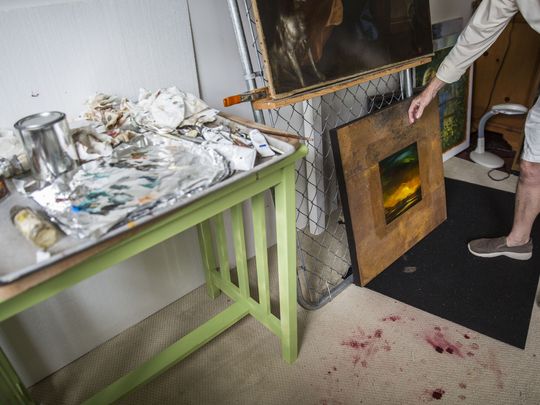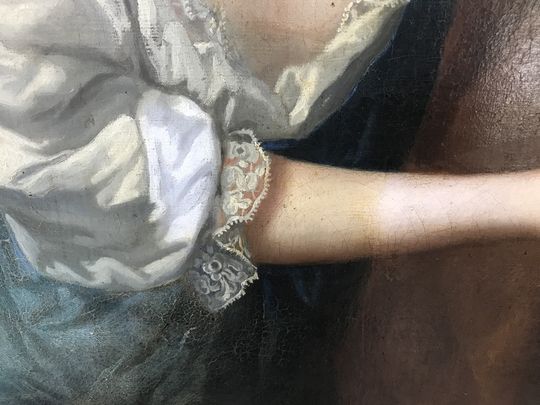Art in peril: Accidents happen, and Naples galleries and conservators have seen them all

Art in peril: Accidents happen, and Naples galleries and conservators have seen them all
Harriet Howard Heithaus – May 18, 2018

William Meek remembers the day a forklift accidentally rammed the crate holding a $20,000 painting in an exhibition he had organized — and went right through the painting.
It was the kind of nightmare galleries and curators dread but that happens in a physical world: “Great art isn’t necessarily immortal art,” observed Meek, curator emeritus at Harmon-Meek and Harmon-Meek Contemporary galleries.
He and other curators and art conservators had heard — as anyone who reads weekly gossip magazines has — about the 1943 Picasso, “Le Marin,” that was damaged at Christie’s auction house just days before it was to be sold for an estimated $70 million.

According to several stories, an errant paint roller extension rod leaning against a wall slipped and went through the lower right corner of the painting owned by casino billionaire Steve Wynn. Christie’s has remained silent on the type and extent of the damage.
Of course, any repair work is going to affect art’s value Meek said. “The painting in our exhibition eventually sold for $7,000,” he recalled.
That was after extensive work had gone into repair with restoration experts at the University of Minnesota.
“The painting was oil on Masonite panel and it was cracked in half,” he recalled of the 24- by 36-inch work by Aaron Bohrod, who was known for his trompe d’ oeil and landscape paintings.
Compounding the misfortune was Bohrod’s insistence that the insurance company pays him what he considered full value for his painting. “Full value” can be its own stumbling block, depending on the economy and the reputation of the artist.

The early cleaning process of the 1680’s painting Wagner recently finished restoring at his work studio in Naples, Fla. (Photo: Photo courtesy of Tom Wagner)
Damage from Day 1
The vast amount of damage Morley Greenberg, director at the Marianne Friedland Gallery in Naples, has seen done to paintings isn’t in such freak accidents. Many people in Florida, especially, do their own damage by where they hang the art.
Florida sunlight is especially brutal on prints and watercolors, he said. “It fades your drapes. It fades your carpet. It’s going to fade your art,” he said.
Greenberg and every other person contacted said faded prints generally are a lost cause. Even torn paper can be repaired by a good expert; faded inks cannot.
“I always ask people, ‘Where are you thinking of hanging this?’ ” Greenberg said, warning every customer that direct sunlight is damaging. Even with ultra-violet filtering glass, limited exposure, if any, is best.
Greenberg has another worry for Florida art lovers: power outages. After Hurricane Irma, some art sat for weeks in hot, humid rooms, where humidity can bring out brown mold known as “foxing” on paper and can mold oils and acrylics as well. To avoid the expense of having them removed, Greenberg said all important art should be stored in an air-conditioned room with guaranteed power from a generator or taken with the owner to an air-conditioned location.

Beware the bubble wrap
Just don’t wrap them directly in bubble wrap, warned Tom Wagner, an art restorer in Naples who has worked with everything from 17th-century pieces, art painted over other art, and damaged paper works in his 30-plus years.
“If the work is exposed to any heat that wrap can melt into it. Some of the worst work I’ve had to do is from bubble wrap,” he said. Wagner suggested putting waxed paper between the wrap and the work to catch any melting.
Wagner has worked as an art conservator for more than 30 years, and he’s faced paintings with significant damage. He’s worked with two paintings that had been rammed by forklifts during a move. He’s the official restorer for the “Highwaymen” paintings by itinerant black artists that are a Southern art legacy. Those, he said, take special care. “They generally used regular house paint,” he explained, and it could have been nearly any brand, any composition, and quality when it was applied.
The one he has printed on his business card, however, is an 1890 painting of a child holding a cat. A triangular tear had left it without a center, and the torn area was missing. Wagner, who is an artist himself, had to create part of the cat’s face, its neck and the tips of the holder’s fingers. It was a full month of work.
More often, he said, humidity damage and smoke damage are the problems. Even a house with a fireplace can leave your art yellowed. Cracks in the paint aren’t necessarily a problem, he said:
“That’s a sign that it’s an old painting. If someone brought me a painting with hairline cracks, I’d say leave it alone. But if it’s started to peel or flake off it needs attention.”
Both Wagner and Viviana Dominguez, with Art Conservators Lab LLC, emphasize that true conservators make their work completely reversible.
It serves the needs of forensics: If someone needs to take the painting down to the original piece, it can be done, Dominguez explained.

“The materials conservators use age, too,” she said. ” In a hundred years, the technology may change and they may want to restore the paintings with these new materials. So you have to be able to go back to the original.”
Art Conservators Lab has offices in Naples and Fort Lauderdale and works extensively with Florida museums. But Dominguez, who is a qualified National Heritage Responder, has worked directly with badly damaged works from museums in Haiti after the 2010 earthquake there, helping to dig out art from under the rubble.
Closer to home, one of her concerns is amateur restoration: “People say, ‘Oh, I can fix that,’ but they don’t know what they’re doing with the kinds of glue they use and what they do to the paint,” she said.
On the practical level
On a practical level, Jack O’Brien, curator for the Naples Art Association, said he learned one of his best maxims in art preservation from the late Sandy Nash, former art curator for what is now The Baker Museum.
“Two hands for the artwork. That helps you concentrate on what you’re doing with it,” he said. He has two other maxims: Don’t pick up a painting by its top frame bar or the hanger wire.
“Some things are framed loosely and you pick up by the top bar, it can come off,” he said.
He’s a firm believer in using clean gloves to carry art as well. “You have oils in your hands. That is being transferred to the art and it’s going to stay there until it’s cleaned off.”
